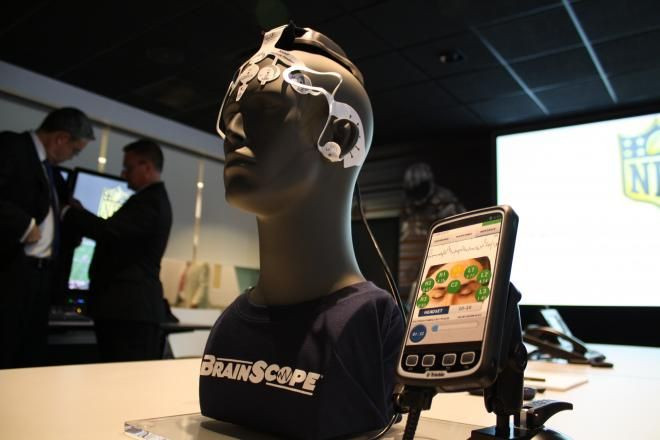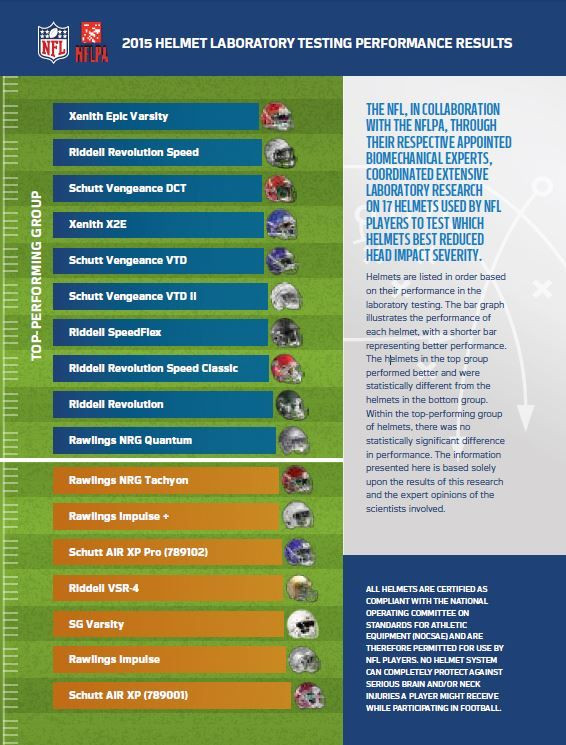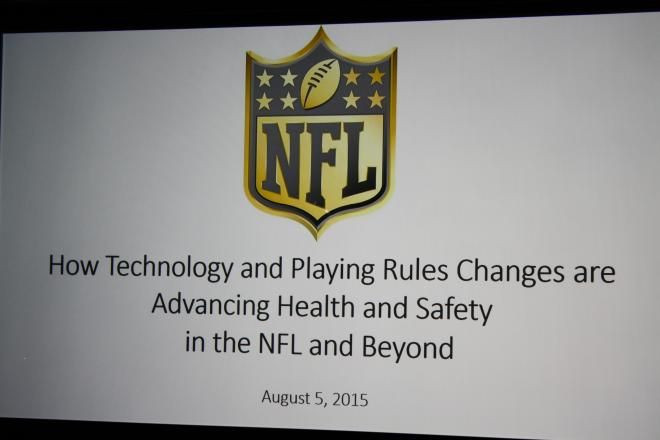NFL Player Health And Safety: Concussion Research Improves As The NFL Looks To Outside Sources

Today’s parents have a difficult decision to make when it comes to enrolling their children in a youth football league. On the one hand, youth football offers kids an avenue for regular exercise and a chance to connect with other kids. On the other hand, the consequences of sustaining a traumatic brain injury are well documented, especially when it comes to football and other contact sports. Concussions among players in the National Football League (NFL) is a prevailing issue that has received a great deal of attention. Luckily for football fans, all that attention has resulted in some promising results.
This past Wednesday, Medical Daily was invited to the NFL’s offices in New York City for the second in a series of media briefings discussing player health and safety updates. Concussions sustained by players during regular season games have dropped from 173 in 2012 to 148 in 2013 to 112 in 2014. This represents a 35 percent decline in the last three seasons alone. Although impressive, the league still has a long way to go before any of its efforts can be considered a success.

The NFL Is Becoming Safer Because The NFL Isn’t Really Involved
The NFL is good at a lot of things, but when it comes to the health and safety of its players, the league decided to leave it to the professionals. One of those professionals is Dr. Elizabeth “Betsy” Nabel, chief health and medical advisor for the NFL. Last February, Nabel was brought in by NFL Commissioner Roger Goodell to become the league’s senior medical expert. Some of Nabel’s recent positions include president of Harvard-affiliated Brigham and Women’s Hospital and professor of medicine at Harvard Medical School. With no prior affiliation to the NFL, Nabel was the perfect candidate for furthering the league’s player health and safety standards.
Nabel kicked the meeting off by listing the three initiatives put forth by her advisory committee: support medical research aimed towards improving player safety, gain a better understanding of behaviors and physical health, and increase communication and transparency in regard to the health and safety of NFL players. Nabel and her colleagues are tackling the NFL’s concussion issue with the help of rule changes and enforcement, injury protocols, coaches and players embracing the change in culture, and improved equipment. Helmets are clearly the first line of defense against traumatic brain injuries, which is why technological advances have centered around this piece of protective equipment.
The Helmet Testing Study, led by Dr. Jeff Crandall, chairman of the NFL’s Engineering Subcommittee, assessed 17 different helmet designs that represent “more than 99 percent” of those worn by NFL players. It’s worth noting that, like Nabel, Crandall’s background is not with professional football, but with automobile safety. Helmets were strapped to test dummies at an independent helmet testing laboratory and endured impact velocities that mimicked on-field collisions. The result was a list of the top 10 performing helmet designs featured on a graphic that will be posted in the locker rooms of all 32 NFL teams.

What Changes We Can Expect To See This Season
So other than improvements to protective equipment, what changes can we expect to see this upcoming season? In the past 10 years, the NFL has implemented nearly 40 rule changes for the benefit of player safety. Statistics show that these recent rule changes, including the outlawing of helmet-to-helmet hits, hits to defenseless players, and peel-back blocks, have already transformed how the game is played. Hits to defenseless players last year were down by 68 percent compared to the 2013 season and concussions caused by helmet-to-helmet hits in regular season games were down by 43 percent. This season the term defenseless receiver will extend to wide receivers when a pass is intercepted.
Perhaps the most important change to the NFL in recent years will be featured for the first time this season. Timeouts in football are typically called by coaches, referees, and quarterbacks. With the addition of the Medical Timeout this season, a certified athletic trainer (AT) watching all the action from a press box will be able to stop the game whenever they feel a player has sustained an injury significant enough to require a halt in play. AT’s, also known as injury spotters, are not only positioned above the action to provide a perfect vantage point, but they are also given access to every camera angle available from the field.
Once the AT sees a potential injury sustained by a player who is attempting to stay in the game, a signal is sent to the side judge who calls a timeout which freezes the game and play clock. This stoppage does not deduct injury timeouts from either team. From there, the medical staff of the player’s team is alerted and an evaluation is conducted before a return-to-play decision is made. If the player’s injury is deemed a possible concussion, they will undergo the league’s mandatory concussion protocol before they can return to full contact.

What We Can Expect To See Moving Forward
The future of player safety in the NFL is bright and that’s mainly due to the league’s partnership with other national and international organizations, including the Fédération Internationale de Football Association (FIFA), the Canadian Football League (CFL), and the United States Department of Defense. The NFL’s partnership with General Electric (GE) helped launch the Head Health Initiative to further research and development of new brain imaging technologies. Six grand prize winners of the $10 million Head Health Initiative I were announced last month, with each winner receiving $500,000 in addition to the $300,000 awarded to the original 16 finalists.
One of the Head Health Challenge I finalists, BrainScope Company, Inc. from Bethesda, Md., was on hand last Wednesday to demonstrate its urgent care, handheld electroencephalogram-based traumatic brain injury detection technology. BrainScope and other finalists are focusing their work on speed diagnosis for TBIs. Evidence continually shows that changes in the brain that indicate a TBI often dissipate before physicians have a chance to study them. Moving forward, research into TBIs will focus on the quickest way to diagnose a concussion.

According to Dr. Richard Ellenbogen, co-chairman of the NFL’s Head, Neck and Spine Committee, “The safest place in America to get injured is probably on a professional football field on any given Sunday because there are 17 physicians on the field.”
Today on the sidelines of all 32 NFL teams, we can find Microsoft Surface tablets that carry the electronic medical records for each player. Every NFL game features an average of 27 healthcare professionals capable of providing care for all 22 players on the field at one time. Following a downward trend in concussion statistics and significant changes that will be on display each Sunday this upcoming fall, it’s safe to say we can expect some big developments in the near future.



























